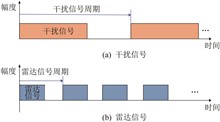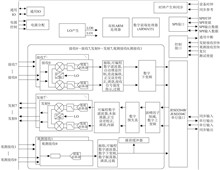In response to the design challenges engendered by the necessity to balance power consumption,volume,and cost in the system design of photoelectric sensors such as lidar and laser ranging,a time-to-digital conversion (TDC) circuit is constructed through the employment of a low-cost Xilinx Spartan 6 FPGA,and a time-domain single-slope-type analog-to-digital converter (ADC) with a sampling rate of 1.25×108/s and an 8-bit resolution is attained.The actual measurement demonstrates that this time-domain ADC exhibits good linearity after calibration:differential nonlinearity (DNL) [-0.49,0.62] LSB,integral nonlinearity Least Significant Bit (INL)[-0.98,0.74] LSB.The highest effective bit reaches 6.2 bits,and the measurement range is [0.47,2.7] V.It is ascertained that only 13% of the FPGA SLICE is occupied.This time-domain ADC exploits the high-precision clock source CDCM61004 (125 MHz,RMS Jitter<1 ps) as the system clock.The actual measurement manifests that when sampling a high-frequency signal of 50 MHz,the effective bit could reach 5.8 bits.When tested and applied in the laser ranging sensor,the time-domain ADC is capable of collecting the echo signals of the laser pulses and simultaneously obtaining the amplitude and time information of the echo signals,achieving a flexible and compact system design.
The mainlobe interference,especially the self-defense mainlobe interference,seriously affects the radar performance since the signals of the mainlobe and the radar echo generated by a real target are within the same beamwidth.Therefore,suppressing mainlobe interference is one of the hot spots and difficulties in the current radar field.To address this issue,a radar mainlobe interference suppression approach based on signal reconstruction is proposed.Firstly,the pulse signals of mainlobe interference are eliminated.Then,based on the modified iterative method with adaptive thresholding (MIMAT),the interfered pulse signals are reconstructed along the slow time dimension.The simulation results indicate that the proposed approach not only could effectively suppress the mainlobe intermittent interference,but also has high robustness to the amount and period of the interference pulses,which has a promising engineering application prospect.
The concept of software-defined radio (SDR) has been proposed for many years.However,owing to the limitation of integrated circuit design and manufacturing technology,the development of SDR chip technology has been relatively slow for a long time.In recent years,with the rapid development of integrated circuit design and manufacturing technology,SDR chip technology has made significant progress,which effectively promotes the development of radio frequency (RF) microsystems.Firstly,the development history of SDR chip technology is reviewed,and the SDR chip based on the zero intermediate frequency (ZIF) system on chip (SoC) is introduced.Secondly,the architecture of a traditional RF microsystem is compared with that of an RF microsystem based on the ZIF SoC.Thirdly,the design of RF microsystems is analyzed from three aspects,i.e.,prototype design,packaging design,and circuit design.Fourthly,the implementation and integration process of RF microsystems are elaborated.Finally,the future development of RF microsystems is prospected.










